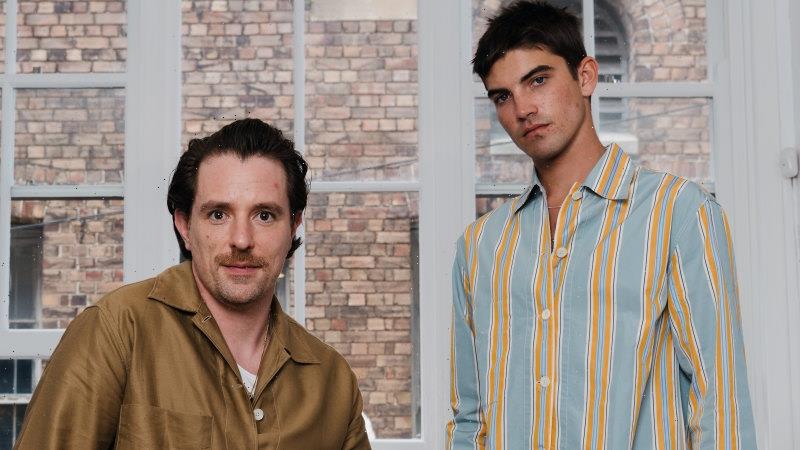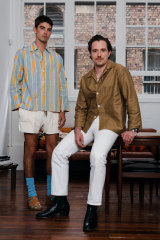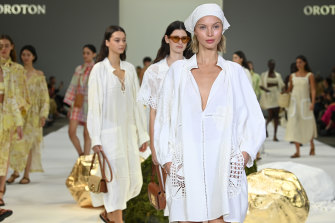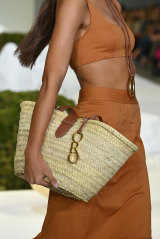Australian designers such as Nicky Zimmermann, Christopher Esber and Dion Lee have taken the exhausting and expensive route of runway shows and red carpet outings to gain international attention but Jeremy Hershan has found a shortcut with his new label Haulier.
Designer Jemery Hershan and model Cal Fernie wearing Haulier.Credit:James Brickwood
Launching a utilitarian tote in November, the former creative director of RM Williams immediately signed deals with influential global retailers Matchesfashion and MyTheresa, who are now ready to descend on his new ready-to-wear range.
“They loved the elevated approach to everyday items that we brought to the tote,” Hershan said. “I’m taking that approach to a curated capsule wardrobe. It’s my take on timeless fashion. The best designed pieces are like Levis 501s that anyone can wear, men and women, that are just as good now as when they were created.”
Trained in fashion at Melbourne’s RMIT before working in Paris and London’s Savile Row, Hershan designed for heritage brands Aquascutum and Dunhill. In 2015 he returned to Australia as creative director of RM Williams.
Working for three years in a pair of classic leather RM Williams boots helped shape Hershan’s tailored trajectory for Haulier from sturdy bags to stylish clothes.
“That tradition of manufacturing and craftsmanship at RM Williams is in a league of its own in Australia,” he said. “I was very much inspired by the generational skills in the factory and by creating quality products. The Craftsman boot, designed in the ’60s, has not changed.”
For two years after leaving RM Wiliams, Hershan worked with manufacturers in Europe where the bag’s durable fabric is created using antique shuttle looms.
Totes first. The Haulier bag which introduced a new Australian label to the world.
“Now the bag has extended to the wardrobe of goods. I’m very much inspired by the ’60s and ’70s travel and celebrity style.”
The jet set route from Australia to prestigious international stockists using bags is also being explored by heritage accessories brand Oroton, revitalised by former Country Road creative director Sophie Holt.
Oroton had been in administration before Caledonia chief investment officer Will Vicars rescued the company from administration with a $25 million offer in 2018. Holt has turned the company’s creative fortunes around, reviving interest in their bags before launching a ready to wear collection in 2019.
Oroton on the runway at Australian Fashion Week, Carriageworks on June 1.Credit:Getty
Now overseas expansion is underway with leading London department store Selfridges currently hosting an Oroton pop-up, showcasing the sculptural day wear in a coastal palette.
“We are excited to have recently launched our international wholesale business,” Holt said. “It made sense to start with accessories as they are the base of our brand. We have now added the clothing and where possible prefer to present the brand as a whole giving our customers the full Oroton story.”
Oroton making its runway debut at Australian Fashion Week on June 1.Credit:Getty
“With Oroton, the first step was redefining the look and feel of the accessories, creating a modern and relevant feel that still spoke to the heritage and craftsmanship of the brand. Once we had the new handwriting of the accessories it was easier to use that as a base to inform the
look and feel of the clothing.”
It’s a brand evolution that has been tried and tested overseas. French luxury leather goods label Hermés launched its first women’s ready to wear line in 1967 with Catherine de Karolyi, before enlisting designers such as Martin Margiela and Jean Paul Gaultier. Italian luggage supplier Prada staged its first debut show in 1988 while Louis Vuitton finally moved beyond monogrammed bags in 1998 with American designer Marc Jacobs’ spectacular collections.
“To inform the look of the clothing we took a vintage slant from the history of the brand and combined that with utility details,” Holt said. “A sort of charming utility was created.”
Both brands are counting on utilitarian appeal for greater international success. With Haulier, Hershan accepts that overseas sales and a global perspective are essential for the survival of Australian luxury brands.
“Australia will always be the home of the brand but the market here has a ceiling for the types of products I’m making. There’s a much broader audience when you go global.”
Make the most of your health, relationships, fitness and nutrition with our Live Well newsletter. Get it in your inbox every Monday.
Most Viewed in Lifestyle
From our partners
Source: Read Full Article




